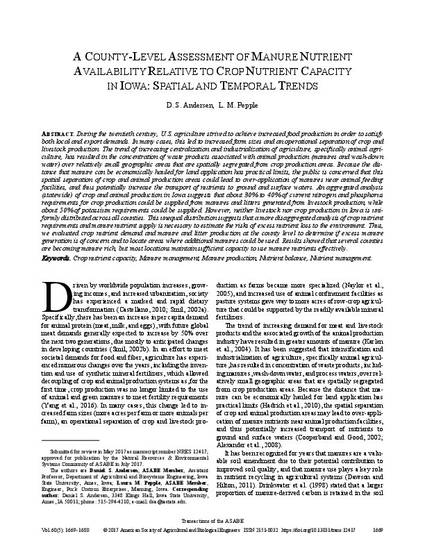
During the twentieth century, U.S. agriculture strived to achieve increased food production in order to satisfy both local and export demands. In many cases, this led to increased farm sizes and an operational separation of crop and livestock production. The trend of increasing centralization and industrialization of agriculture, specifically animal agriculture, has resulted in the concentration of waste products associated with animal production (manures and wash-down water) over relatively small geographic areas that are spatially segregated from crop production areas. Because the distance that manure can be economically hauled for land application has practical limits, the public is concerned that this spatial separation of crop and animal production areas could lead to over-application of manures near animal feeding facilities, and thus potentially increase the transport of nutrients to ground and surface waters. An aggregated analysis (statewide) of crop and animal production in Iowa suggests that about 30% to 40% of current nitrogen and phosphorus requirements for crop production could be supplied from manures and litters generated from livestock production, while about 50% of potassium requirements could be supplied. However, neither livestock nor crop production in Iowa is uniformly distributed across all counties. This unequal distribution suggests that a more disaggregated analysis of crop nutrient requirements and manure nutrient supply is necessary to estimate the risks of excess nutrient loss to the environment. Thus, we evaluated crop nutrient demand and manure and litter production at the county level to determine if excess manure generation is of concern and to locate areas where additional manures could be used. Results showed that several counties are becoming manure rich, but most locations maintain sufficient capacity to use manure nutrients effectively.
Available at: http://works.bepress.com/daniel_andersen/55/

This article is published as Andersen, Daniel Steven, and Laura M. Pepple. "A County-Level Assessment of Manure Nutrient Availability Relative to Crop Nutrient Capacity in Iowa: Spatial and Temporal Trends." Transactions of the ASABE 60, no. 5 (2017): 1669-1680. DOI: 10.13031/trans.12417. Posted with permission.